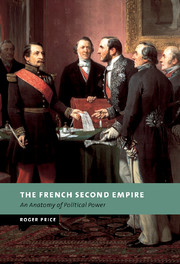Book contents
- Frontmatter
- Contents
- Acknowledgements
- List of abbreviations
- Introduction
- PART ONE THE RISE OF LOUIS-NAPOLEON BONAPARTE
- PART TWO STATE AND SOCIETY
- 2 Napoleon III and the Bonapartist state
- 3 The system of government
- 4 The management of elections
- 5 Preserving public order
- 6 Constructing moral order
- 7 Creating the conditions for prosperity
- Conclusion to Part II
- PART THREE THE RISE OF OPPOSITION
- PART FOUR WAR AND REVOLUTION
- General conclusion
- Select bibliography
- Index
2 - Napoleon III and the Bonapartist state
Published online by Cambridge University Press: 14 August 2009
- Frontmatter
- Contents
- Acknowledgements
- List of abbreviations
- Introduction
- PART ONE THE RISE OF LOUIS-NAPOLEON BONAPARTE
- PART TWO STATE AND SOCIETY
- 2 Napoleon III and the Bonapartist state
- 3 The system of government
- 4 The management of elections
- 5 Preserving public order
- 6 Constructing moral order
- 7 Creating the conditions for prosperity
- Conclusion to Part II
- PART THREE THE RISE OF OPPOSITION
- PART FOUR WAR AND REVOLUTION
- General conclusion
- Select bibliography
- Index
Summary
THE CONSTITUTION OF THE SECOND EMPIRE
The coup d'état was followed by a period of rule by decree, of dictatorship in the ancient Roman sense of the word, when the normal rule of law was suspended with the assent of the population, given by plebiscite on 21 December 1851. Continuing repression completed the identification of the new regime with the political right, giving it a reactionary image from which it would never escape. During the four months that followed, its institutional structures were established. The constitution of 14 January 1852 transformed the government of the Republic and would require little further modification before becoming the constitution of the Second Empire. It was drafted mainly by Rouher, by-passing the consultative commission originally established as a means of attaching leading political figures to the regime. However, the President himself laid down its basic structure. The model followed was the Napoleonic constitution of the Year XII. Indeed, in a proclamation of 14 January 1852 Louis-Napoleon insisted that
I have taken as models the political institutions that once before, at the turn of the century, in similar circumstances, gave a new strength to a shaken society and raised France to the height of prosperity and grandeur. I have taken as models the institutions that, instead of vanishing at the first outbreak of popular disturbances, were toppled only by the coalition of all of Europe against us. In short I asked myself: since France has been functioning for the past fifty years only thanks to the administrative, military, judicial, religious and financial organisation of the Consulate and Empire, why should we not also adopt the political institutions of that period?[…]
- Type
- Chapter
- Information
- The French Second EmpireAn Anatomy of Political Power, pp. 41 - 53Publisher: Cambridge University PressPrint publication year: 2001



